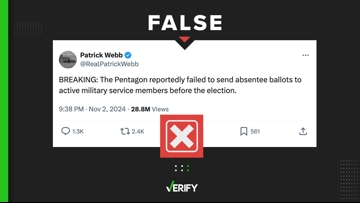On Oct. 4, 2023, the Federal Emergency Management Agency (FEMA) and the Federal Communications Commission (FCC) will conduct a national test of the Integrated Public Alert and Warning System (IPAWS). FEMA says the test will take place at approximately 2:20 p.m. ET.
Some have claimed in the lead-up to the test that the federal government has ulterior motives beyond just testing the emergency system. One person shared in a viral Reddit post text messages from their landlord claiming they would temporarily shut off their tenants’ power because “most newer appliances may be at risk” of frying or even fires because of the test.
VERIFY reader Elizabeth texted us to ask if claims that the test is “actually a method of getting as many people possible connected in order to cause their devices to malfunction” are true.
THE QUESTION
Will the nationwide emergency alert test damage devices?
THE SOURCES
- Federal Emergency Management Agency (FEMA)
- Federal Communications Commission (FCC)
- CTIA, an association representing the U.S. wireless communications industry
- U.S. federal code
- The Integrated Public Alert and Warning System Modernization Act
THE ANSWER
No, the nationwide emergency alert test will not damage devices. The test will use the same alert system used tens of thousands of times across the country over the past 12 years without issue.
WHAT WE FOUND
On Oct. 4, the Federal Emergency Management Agency (FEMA) will test two parts of its public alerting system: Wireless Emergency Alerts (WEA) for cell phones and the Emergency Alert System (EAS) for radios and televisions.
Both systems have been used thousands of times for real emergencies without incident. FEMA has conducted multiple nationwide tests of these systems in the past decade. Neither system forces devices to connect with or send information to other devices or the government.
FEMA’s national system to alert the public of emergencies is the Integrated Public Alert & Warning System (IPAWS), FEMA says. IPAWS allows a local or national authority to quickly send out an emergency alert to cell phones, radio, televisions and the National Oceanic and Atmospheric Administration's (NOAA) Weather Radio.
Wireless Emergency Alerts (WEAs)
IPAWS alerts cell phones through WEAs. While most new smartphones support WEAs, many older phones don’t; the Federal Communications Commission (FCC) says about 83% of consumers’ phones support WEAs. If your phone supports WEAs, then you’ve probably received one before — the FCC says the WEA system has been used more than 84,000 times since its 2012 launch.
CTIA, an association representing the U.S. wireless communications industry, says there are four types of WEAs:
- AMBER alerts
- Imminent threat alerts for severe disasters and weather events
- National alerts issued by the President or a designee
- Opt-in test messages from state or local officials.
WEAs are not regular text messages, and can be targeted to a specific area by broadcasting the alert from specific cell phone towers that cover whichever area needs the warning, CTIA says. This is a one-way broadcast, meaning your phone does not send anything back to anyone as a result of this alert.
“Since WEA messages are broadcasted from a cell site, your device cannot send any information about you, your device or the WEA message back to your provider or to the government,” CTIA says. “The WEA program cannot be used to track your location or gather your personal data.”
Emergency Alert System (EAS)
IPAWS alerts AM, FM and satellite radio, as well as broadcast, cable and satellite TV, through the EAS. The government doesn’t hijack the airwaves and broadcast EAS messages and tests themselves. Instead, EAS participants such as TV channels, radio channels and cable providers are the ones who broadcast EAS messages once they receive an IPAWS alert, according to U.S. federal code.
Again, you’ve probably experienced an EAS broadcast, and more specifically an EAS test, sometime in the past. EAS participants have run weekly and/or monthly tests for years, and these tests are now required by federal law. You can see an example of a required monthly EAS test here.
National IPAWS testing
This will be the third nationwide WEA test and the seventh nationwide EAS test, according to FEMA. The last nationwide test of these systems was in 2021.
The Integrated Public Alert and Warning System Modernization Act, which was signed into law in 2016, requires FEMA to conduct “periodic nationwide tests of the public alert and warning system” at least once every three years.
VERIFY could find no evidence of any reports of widespread device or appliance failure caused by the last nationwide test, or by any of the other thousands of transmissions of WEA or EAS messages.













